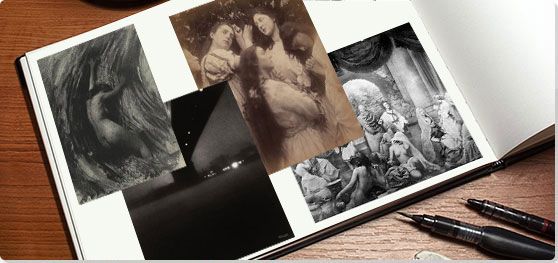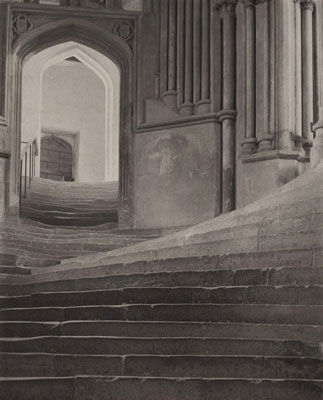Summary of Pictorialism
Pictorialists took the medium of photography and reinvented it as an art form, placing beauty, tonality, and composition above creating an accurate visual record. Through their creations, the movement strove to elevate photography to the same level as painting and have it recognized as such by galleries and other artistic institutions. Photography was invented in the late 1830s and was initially considered to be a way in which to produce purely scientific and representational images. This began to change from the 1850s when advocates such as the English painter William John Newton suggested that photography could also be artistic.
Although it can be traced back to these early ideas, the Pictorialist movement was at its most active between 1885 and 1915 and during its heyday it had an international reach with centers in England, France, and the USA. Proponents used a range of darkroom techniques to produce images that allowed them to express their creativity, utilizing it to tell stories, replicate mythological or biblical scenes, and to produce dream-like landscapes. There is no straightforward definition of what a Pictorialist photograph is, but it is usually taken to mean an image that has been manipulated in some way to increase its artistic impact. Common themes within the style are the use of soft focus, color tinting, and visible manipulation such as composite images or the addition of brushstrokes.
Key Ideas & Accomplishments
- Pictorialism was closely linked to prevailing artistic movements, as the photographers took inspiration from popular art, adopting its styles and ideas to demonstrate parity between it and photography. Movements that were particularly influential were Tonalism, Impressionism and, in some instances, Victorian genre painting.
- Pictorialists were the first to present the case for photography to be classed as art and in doing so they initiated a discussion about the artistic value of photography as well as a debate about the social role of photographic manipulation. Both of these matters are still contested today and they have been made ever more relevant in the last decades through the increasing use of Photoshop in advertising and on social media.
- The movement led to great innovation in the field of photography with a number of the photographers associated with it responsible for developing new techniques to further their artistic vision. This laid the foundations for later advances in color photography and other technical processes.
Important Photographs and Artists of Pictorialism
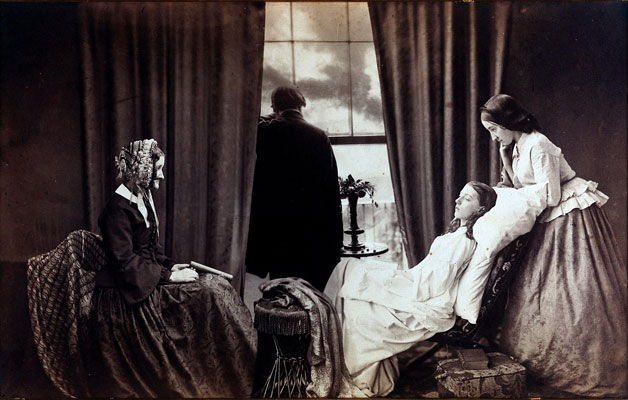
Fading Away
This composite print, combining five different negatives, focuses on an intimate scene of a very sick young woman, surrounded by three family members. To the left, her mother, sits in profile, her gaze resigned. To the right, an older sister, bends over the back of the chaise longue and in the center, the father stands with his back to the viewer, as he looks out the window, his dark shape outlined against the light. Various elements - the closed book that rests abandoned on the mother's knee, the two women watching the dying girl intently as if she might speak, and the contrast between dark and light - create an emotional impact. Robinson employs chiaroscuro to contrast the somber hues of the parents' clothing with the white worn by the dying girl. This is further emphasized by the dark drapes at the window which frame a turbulent sky reflecting the grief within the room. The subject matter is drawn from a wider 19th century obsession with death and a British trend for paintings that featured sick or dying children.
Robinson pioneered the composite image, which became a foundation of Pictorialism. To his contemporary audience the photograph was controversial, as many felt that photography was too literal a medium to portray such an intimate and painful scene. Despite its realism, however, the image contains elements of 19th century symbolism drawn from genre painting of the period with the white of the two young women indicating purity and innocence while the open window and its verticals suggest the ascent to heaven. This controversy in conjunction with the fact that the print was purchased by Prince Albert, Queen Victoria's husband, ensured Robinson's popularity. Robinson's composite images, or montages, are predecessors to the later works of Mortensen, Duane Michals, Lucas Samaras, and Cindy Sherman, amongst others.
Albumen silver print from glass negatives - George Eastman House Collection, Rochester, New York
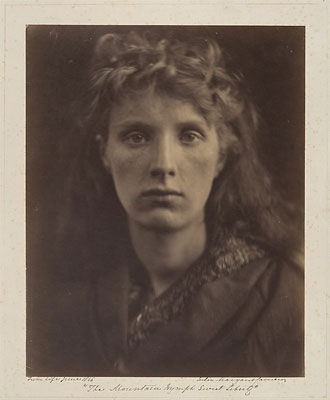
The Mountain Nymph Sweet Liberty
This portrait shows a model, known only as Miss Keene, staring directly at the viewer with an expression that hints at wildness, which is echoed by her tumbling hair. She fills the frame, dramatically emerging from the dark background and her pale features are illuminated by the contrast between the two, perhaps indicating the transition from adolescence to adulthood. The most notable thing about the image is the startling sense of presence of the model which raises all sorts of questions about both the real and imagined young woman portrayed in the photograph. Sir John Herschel, Cameron's friend and mentor, wrote of the image that "She is absolutely alive and thrusting out her head from the paper into the air". While Herschel was famous as an astronomer, he had a deep interest in photography, and is credited as the first to use the word 'photography', derived from the Greek for 'light writing', to describe the new media.
This portrait's title is taken from a line in John Milton's L'Allegro, a pastoral poem from the 17th century which extols the virtues of an active and cheerful life, it reads:
Come, and trip it as you go
On the light fantastic toe;
And in thy right hand lead with thee
The mountain nymph, sweet Liberty.
It is possible that the choice of title reflects Cameron's belief that women should be more active and involved in society. Although, as an aristocratic older woman, Cameron was given more leeway than most, restrictive notions of appropriate behavior for women would have shaped and controlled her activities and her involvement with male-dominated photographic circles.
As art critic Laura Cumming noted, Cameron "revolutionised photography and immortalised the age of the eminent Victorian through her monumental photographs with their muzzy focus and dramatic use of light." It has been also suggested that Cameron's combination of mythology and character-driven portraiture influenced the approach of the Pre-Raphaelites, particularly Dante Gabriel Rossetti. While her images were originally met with harsh criticism, in 1873 The Times reviewed her work, comparing it to the art of Giotto, Van Dyck, and Reynolds. Her psychologically compelling photographic portraits, such as this, equaled the emotional complexity that could be achieved in paint, making them important to both the development of photography as a whole and particularly to Pictorialism. The photographer herself said, "My aspirations are to ennoble photography and to secure it for the character and uses of high art".
Albumen silver print from glass negative - The Metropolitan Museum of Art, New York, New York
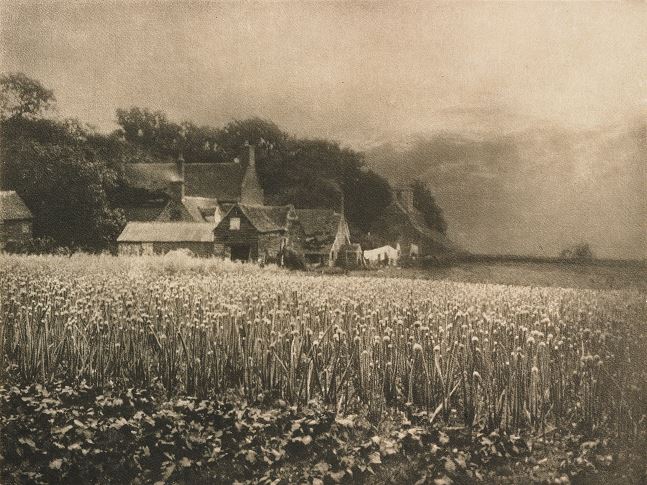
The Onion Field, Mersea Island, Essex
In Davison's landscape, storm clouds gather over a distant farmhouse, the darker foreground with its low growing plants accentuates the stalks of the onions and the flowers above catch the light. The white of the onion flowers is echoed in the sky and the smoke emerging from the farmhouse and these highlights create a vibrant sense of atmosphere. The photograph was created using a pinhole camera, a device that produces images without the sharp detail of traditional apparatus to create the overall soft focus of the piece. This is further emphasized by the rippling pattern of onion flowers which blur together towards the horizon. Pinhole photography was one of a number of techniques that Davison experimented with in order to create impressionistic images that captured the play of light.
This photograph with the alternative title 'An Old Farmstead' was published in a 1907 issue of Camera Work, but by then, it had already become one of the most significant and controversial works in the debate between Pictorialism and Straight Photography. Although awarded a medal at the 1890 annual exhibition of the Photographic Society of Great Britain, the work ignited a debate, with The Amateur Photographer negatively noting that it "marked [the] advance and influence of what may be termed the 'school of foggy photography','' while, in contrast, The Times found that, "Perhaps no more beautiful landscapes have ever been produced by photographic methods... atmospheric effect is admirably rendered, and, looked at from a suitable distance, the picture gives a wonderfully true rendering of the subject".
Photogravure - Minneapolis Institute of Art
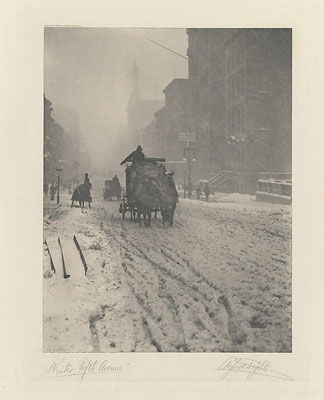
Winter on Fifth Avenue
This iconic print depicts a blizzard on Fifth Avenue as a horse drawn carriage moves toward the viewer, the driver, outlined against the snowy sky, urges the horses forward. In the distance are other carriages and a few pedestrians, dark shapes in the windblown snow. The lines of the ruts in the snow-covered street, which extend from the foreground towards the oncoming carriage, intersect with the movement of snow across the image at a 45 degree angle forming strong, linear compositional elements to the image. In the background the dark shapes of the building merge into the haze of the blizzard. This creates the impression of a Romantic struggle between nature's forces and human labor.
Stieglitz was particularly intent on the effects of atmosphere and here the snow is rendered with a soft focus which makes it look like it has been painted on. This allowed a sharper focus to be placed on the carriage, highlighting it as the central subject. To capture the scene, he spent over three hours in the snow taking a number of photographs, he then spent further time in his darkroom as art critic Sarah Boxer writes, "cropping, touching up and reprinting until he got it right". Stieglitz's images brought to Pictorialism a mastery of artistic effect, combined with a sensibility tuned to the zeitgeist of the times, as Boxer notes, he "always pressed his pictures to represent something beyond themselves". The work, with its emphasis on the patterns in the snow also prefigures Stieglitz's later move to abstraction, in his Equivalents series (1922-1935), which depicted abstract clouds patterns.
Photogravure - The Metropolitan Museum of Art, New York, New York

Last Seven Words
These seven close-up self-portraits depict the photographer as Christ being crucified. Above the images are sayings (known as words) that are biblically attributed to Jesus during his crucifixion. These start with "Father Forgive them, they know not what they do" and end with "It is finished". Each of the seven images relates to one of the sayings and the title of the piece is also taken from these. In 1895 Day launched a project that sought to photographically portray the life of Christ, with himself in the title role. By the time he had finished the project in 1898 he had made more than 250 negatives. To prepare, he let his beard and hair grow, went on extended fasts, and imported props, including a cross and linen, from Syria. These images, viewed by art critics as the strongest in the series, were taken just prior to his staging of a full photographic reenactment of the Crucifixion.
Day's project had several influences, including a trip to Germany in 1890 where he saw the famous Passion Plays. Day was also affected by the writer Oscar Wilde. Wilde was a friend and mentor of Day's, and Day's earlier photographs were often homoerotic male nudes. Wilde's trial in 1895 for gross indecency and his two years of imprisonment had a significant effect on many gay men in his circle, including Day who moved away from imagery with homosexual undertones. Wilde had written, in 1891, of Christ as "God realizing his perfection through pain," and like Wilde, Day seemed to identify with the discrimination and suffering that Christ endured. With this project Day placed himself directly in the role of the persecuted.
In the same manner as Robinson's Fading Away (1858) many viewers found these images unsettling as they utilized a modern, factual medium to present a biblical tale. This controversy was heightened by the sacred nature of the story. Steichen defended Day's work noting that, "Few paintings contain as much that is spiritual and sacred in them as do the 'Seven Words' of Mr. Day...If we knew not its origin or its medium how different would be the appreciation of some of us". Day's combination of self-portraiture and storytelling was innovative in Pictorialism, and an important predecessor for contemporary artists such as Mark Morrisroe, Chris Burden, and Robert Mapplethorpe.
Platinum print - Library of Congress, Washington DC
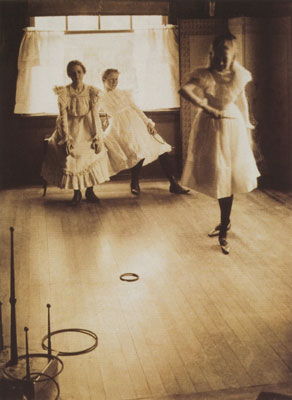
The Ring Toss
This image depicts three girls, attired in white frilly dresses, playing ring toss. The soft focus and bright light from the window, which reflects on the wooden floor, gives the photograph an idyllic feeling which captures the innocence of childhood play. The light also draws the viewer's attention to a ring lying in the center of the pictorial frame which provides an unusual focal point. This image became one of White's best-known and most popular when it was published in 1903, as it portrays an idealized version of upper middle-class life. This was particularly relevant at the turn of the century when traditional class values and structures were being threatened by rapid industrial change and urbanization.
The work greatly resembles William Merritt Chase's painting Ring Toss (1896) which depicts three girls, though younger in age, in a similar formation. White's photograph, therefore, shows an ambition to make photography equivalent to fine art by adopting the composition and subject matter of a noted painting of his day. Unlike Steichen and Stieglitz who later turned to modernist photography, White continued advocating for Pictorialism throughout his career. His work informed the movement in his treatment of light, as art historian Peter Bunnell writes, "White was able to transform the sensory perception of light into an exposition of the most fundamental aspect of photography - the literal materialization of form through light itself. His prints...display a richness, a subtlety, and a luminosity of tone rarely achieved in the history of photography".
Gum Bichromate print - The Metropolitan Museum of Art, New York, New York
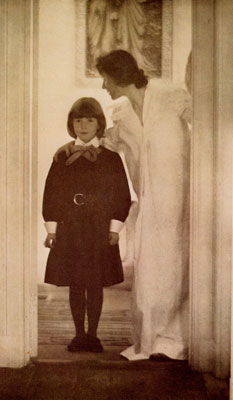
Blessed Art Thou Among Women
This intimate and ethereal portrait shows Agnes Rand Lee, a noted Boston poet and children's book author, and her daughter, Peggy, standing in a doorway. Behind Lee's head is a partially visible painting of the Virgin Mary, a reference to the Annunciation, this is reinforced by the title of the photograph. The folds of Lee's gown echo those of the Virgin and she is dressed in white, a color symbolic of purity. Lee looks towards her daughter with an expression of tenderness, whereas Peggy faces the camera with a purposeful and poised expression before going into the world. The timeless nature of Lee's garment is contrasted with the neat and business-like attire of Peggy, perhaps indicating her future opportunities as a modern woman in a new century. The image's soft focus and hazy light idealizes the figures and furthers the parallels between sacred motherhood and the mother-daughter relationship portrayed in the image.
As art historian Raphael Fitzgerald notes, Käsebier was "one of the most influential photographers of the early 20th century known for soft imagery of mothers and children" and was particularly regarded for her ability to capture the personality of those she photographed. Käsebier was the first woman elected to the Linked Ring Society, and she was part of the founding group, along with Stieglitz, Clarence H. White, and Edward Steichen of the Photo-Secession in 1902. Stieglitz had earlier published this image in Camera Notes in 1900 and he republished it in Camera Work's first issue in 1903.
Photogravure - The Museum of Modern Art, New York, New York
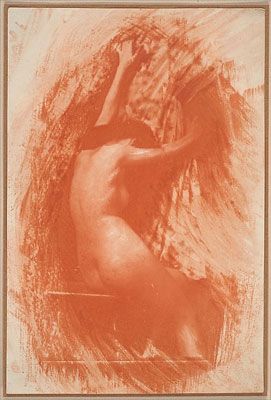
Struggle
This image shows a female nude, her back turned to the viewer, her face lowered as she seems to struggle with the coarse, scratched background. Gum bichromate was invented in 1855 but then seldom used until Demachy took advantage of the technique in the 1890s which allowed for the use of color and brush-like effects in a photograph. Here, the color used references sanguine, a reddish chalk often used in life drawings. The overall effect is Expressionistic, the title reminiscent of Munch's The Scream, as if the image conveys some deep and universal crisis of being. There is a clear sense of movement in the piece which is reinforced by the scratched background. Through the simplified elements of the composition, ambiguity is created; the background might be viewed as a wall that the figure tries to ascend, or a floor which she tries to move across, this causes the viewer to question the image and their own viewing of it.
Along with Puyo, Robert Demachy was a leader of French Pictorialism, cofounding and directing the Photo-Club de Paris. As art historian Julien Faure-Contorton has written, prints like this one were "a photographic revolution at a time when pictorial photographers were struggling to find new and artistic printing methods," and "Demachy's gum prints made him immediately famous throughout Europe and the United States".
Gum bichromate print - The Metropolitan Museum of Art
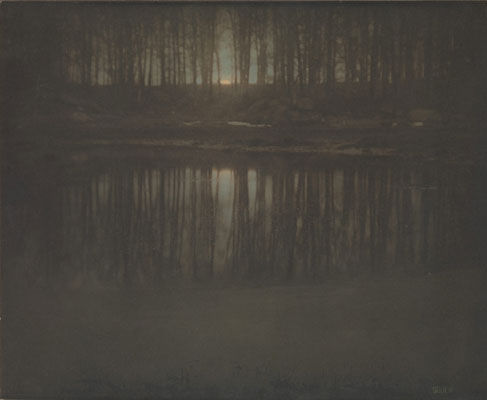
The Pond
This photograph resembles a Tonalist painting in its subject matter, color palette, and poetic atmosphere. The hazy effect, muted foreground, and lack of distinction between reality and reflection render the image dream-like in appearance. The pond in the image was located in Mamaroneck, New York, where Steichen was staying with friends while recuperating from an illness. Steichen hand-colored the bluish green tones by adding layers of gum bichromate to the original platinum black and white plate. Gerry Badger, a photography historian, has suggested that the image was shot at sunset and that it was made darker in the printing process to create the moon-like glow. As art historian David Clark writes, the work was "a landmark image in the development of photography as an art form and arguably one of the finest pictorialist images ever made."
Steichen was in his twenties when he made the image, and already a master of landscapes, often taken at twilight or at night, emphasizing the moon and using gum bichromate for what Clark described as, "a great richness of tone and a beautiful, almost luminous quality." Steichen's work was to influence the subsequent generation of Pictorialists such as Edward Weston and Imogen Cunningham, though they were also to follow his example in turning later to other styles of photography.
Platinum print with applied color - The Metropolitan Museum of Art, New York, New York
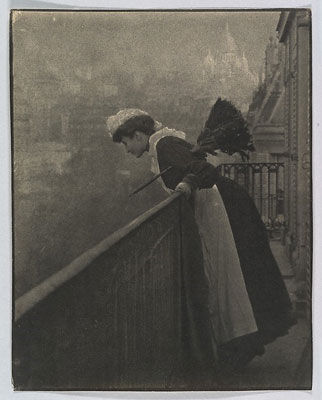
Montmartre
This photograph shows a Parisian housemaid, in her work uniform, peering from an upper level balcony at the street below. Behind her, certain buildings emerge from the haze to give an impression of a busy city extending into the distance, filling the rest of the frame. The contrast between the strong diagonals - of the balcony railing, the handle of the duster pointing at the street below - and the maid's vertical form leaning create a sense of movement and spontaneity, while emphasizing the vastness of the view beneath her.
Puyo led the Pictorialist movement in France and, at the beginning of his career, cofounded the Photo Club of Paris in 1894, eventually becoming the president of the club in the 1920s. Emphasizing photography as an artistic medium, this work was inspired by Edvard Munch's Impressionistic painting Rue Lafayette (1891). In the original painting, however, a gentleman is peering over a balcony and Puyo has replaced him with an attractive young woman in this image. Photographs like this one brought an element of spontaneous observation and a sense of fun to Pictorialism, here Puyo seems to capture an unposed moment in the ordinary life of a household worker. The subject is in contrast to the portraiture of British and American Pictorialists who primarily photographed close friends, family members, or well-known cultural figures.
Bromoil print - The Metropolitan Museum of Art, New York, New York
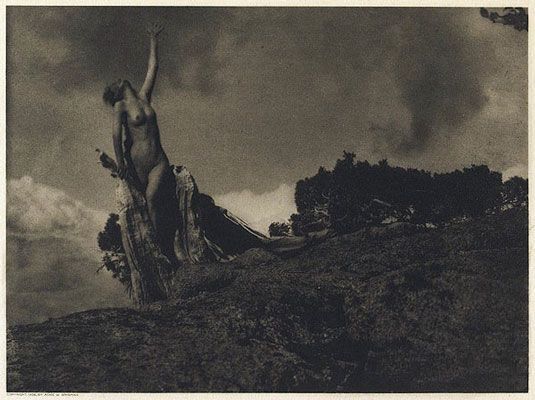
Soul of the Blasted Pine
This photograph combines a nude self-portrait with the rugged landscape of the Sierra Nevada mountains. The nude stands within the trunk of a pine reaching into the stormy sky. The contrast between the diagonal of the mountain, slanting horizontally from right to left, with the verticality of the figure create a dramatic and energetic effect, as if the woman were the embodiment of the tree, springing out of the earth, her reach extending into the clouds at the top of the pictorial frame.
Brigman, originally studied painting, but in 1902 took up photography. In this new medium she noted that her favored subjects were "hearty, unaffected women of early maturity living a hardy out-of-door life...toughened to wind and sun" and her placement of these within landscapes was largely unprecedented within the field of photography. Brigman sought to blur the boundaries between humans and nature, stating that "In all of my years of work with the lens, I've dreamed of and loved to work with the human figure - to embody it in rocks and trees, to make it part of the elements, not apart from them." Brigman extensively reworked her photographs, made during camping excursions into the wilderness, in the studio, often eliminating detail and adding emphasis to create her distinctive style.
Here, this pioneering subject matter is combined with the artist's self-exploration. Rather than eroticizing the nude, Brigman's self-portrait becomes an archetypal symbol, embodying an elemental and independent force, straining to break free from adversity, as represented by the blasted pine. As art critic Christopher Knight notes, "As an artist Brigman was a Symbolist, plain and simple. Her pictures telegraph a cerebral otherworldliness, which laid important foundations of subjectivity for what we now think of as modern art". As the Photo-Secession's only West-Coast photographer, Brigman became a leader in the Pictorialist movement. In their early Pictorialist work, Dorothea Lange, Ansel Adams, Edward Weston and Imogen Cunningham were all influenced by her, often visiting her studio or going on her many photographic camping trips into the wilderness.
Platinum print - The Metropolitan Museum of Art, New York, New York
Human Relations
This composite image shows a man's head at the upper left as an arm reaching at a diagonal from the lower right extends its fingers to grip into the man's eye sockets, while the thumb grabbing his chin, holds his lips shut. The arm, accentuated by a gold armband, reminiscent of those worn by Roman soldiers, becomes symbolic of anonymous power and the impact that abuses of power can have on individuals. The inclusion of the title on the piece reinforces this message. Mortensen's work reflected his interest in psychology and the darker aspects of human behavior. As he wrote, "When the world of the grotesque is known and appreciated, the real world becomes vastly more significant".
Considered to be one of the last great practitioners of Pictorialism, Mortensen developed his practice in the late 1920's, at a time when the F/64 Group, led by Ansel Adams and Edward Weston, emphasized Straight Photography. Mortensen's romantic stills of early film celebrities and his macabre images of witches and incubi were commercially popular but considered archaic. He and Ansel Adams has several notable public debates with Mortensen referring to realistic photography as a 'blind alley'.
As Adams and the straight photograph won the debate, Mortensen's work faded into obscurity, although the past decade has seen a re-evaluation and renewal of interest in his pieces. His work is now viewed as an important precursor to artists like Robert Balcomb and Barbara Kruger. Art critic Chris Campion noted in 2014, "for all the griping of Adams and F/64, it turns out that Mortensen was the true modernist all along, not them. For today, we are surrounded by images of the fantastic and unreal".
Gelatin silver print - Museum of Fine Arts, Houston, Texas
Beginnings of Pictorialism
Early Pioneers
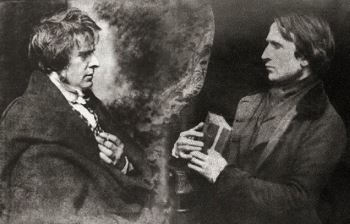
Early photographers such as Julia Margaret Cameron, David Octavius Hill, and Robert Adamson greatly influenced the development of Pictorialism. Hill, who was a successful painter of Romantic landscapes, worked with Adamson, a photographer and printer, between 1843 and 1847, to make over 1500 portraits of people in Newhaven, a small British fishing village. The portraits were compared by some critics of the time to those of Rembrandt. Alfred Stieglitz later dubbed Hill "the father of pictorial photography" and featured his and Adamson's photographs in his publications and at the Little Galleries of the Photo-Secession in 1906.
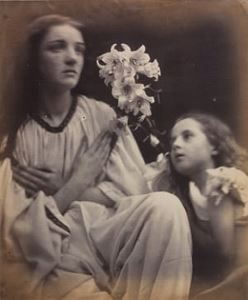
Cameron began taking photographs in 1864, primarily portraits using the wet collodion process that she manipulated in the darkroom. When first shown, her images were criticized as 'slovenly' for their soft focus and cropping. As the Pictorialist movement came to the forefront with the formation of the Linked Ring Society, her photographs were re-evaluated as pioneering and were included in many of the group's annual exhibitions. In contrast to Hill and Adamson's photographs depicting ordinary people, her portraits were usually of well-known figures such as the poet Alfred Lord Tennyson. When she did portray an unknown model, the work was often placed within a Pre-Raphaelite literary or mythical context. Cameron was part of a social circle that included the Pre-Raphaelite artists Dante Gabriel Rossetti, William Michael Rossetti, and Edward Burne-Jones, all of whom were early supporters of her photographic style. Her work reflected their influence and art historian Alastair Grieve has argued that Dante Gabriel Rossetti's painting was equally influenced by her photographs.
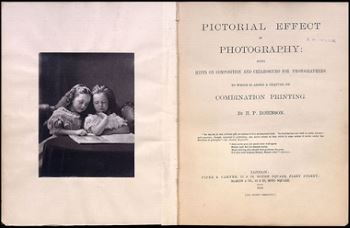
The first recorded use of the term 'pictorial' in relation to photography comes from the English photographer Henry Peach Robinson who used it in the title of his book Pictorial Effect in Photography: Being Hints On Composition And Chiaroscuro For Photographers (1869). Robinson believed that using chiaroscuro, an artistic term referring to dramatic shadows and lighting, would create a pictorial, or painterly, effect in photographs. Robinson also advocated 'combination printing', a technique that he had created in the early 1850s, which involved manipulating multiple photographs into a single image.
International Exhibition of Art Photographers, Vienna, 1891
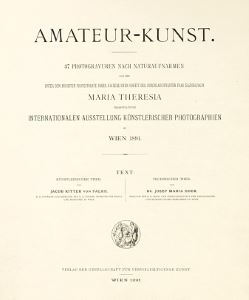
The first exhibition to have a notable impact on the development of Pictorialism was the 1891 Internationale Ausstellung Künstlerischer Photographien (International Exhibition of Art Photographers) in Vienna, Austria and this can be seen as a catalyst for future innovations in the field. Launched and curated by the Club of Amateur Photographers in Vienna, the exhibition showed 600 photographs, including, most notably, the work of English photographers, Alfred Maskell, Lyonell Clark, Lyddel Sawyer, Harry Tolley, and George Davison. Ten American photographers, including Alfred Stieglitz, also had works chosen for the show. These selections placed an emphasis on "photographs of artistic merit". The show had an international impact with The Times in London writing that, "we must call attention to the artistic excellence of the English photographs", the review then went on to praise the work of Davison, noting that "both his landscape and figure pictures make a truly artistic impression".
The Linked Ring, 1892
In 1891 Henry Peach Robinson, along with a number of photographers including George Davison, Alfred Maskell, and Lyddel Sawyer, seceded from the Photographic Society of Great Britain when one of Davison's Impressionistic photographs was rejected for the Society's annual exhibition. In May 1892 Robinson, Davison and Henry Van der Weyde, formed a new group called the Linked Ring, or The Brotherhood of the Linked Ring. The aim of the new society was "the development of the highest form of Art of which Photography is capable". Opposed to the conventional viewpoint that the camera was a mere mechanism for recording actuality, the group sought to be, "a sociable coterie of picture-loving, as separate from purely scientific or practical, craftsmen".
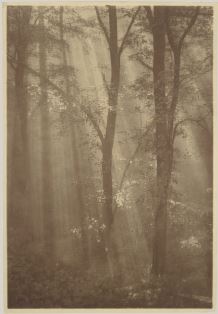
The three founders of the Linked Ring were photographic innovators. Davison used a pinhole camera to create Impressionistic images, Van der Weyde pioneered the photographic use of electric light, and Robinson had developed composite images. Other members of the group, such as Alexander Keighley, also explored new techniques. Keighley worked with carbon prints, manipulating a negative at various stages, to achieve a rich sense of atmosphere in works like The Dayspring from on High (1890s-1900). Exploring new techniques, both in shooting an image, and in darkroom manipulation, to create Pictorial effects was a defining characteristic of the group and of Pictorialism in general. In April 1893, the Linked Ring launched the Salon of Pictorial Photography, an annual exhibition that from 1893 to 1909 promoted pictorial photography on an international scale, and included photographers from other countries including the American Alfred Stieglitz and the French Robert Demachy. Originally the Linked Ring was primarily made up of British photographers, but, subsequently, many Americans joined, and these were known as the 'American Links'.
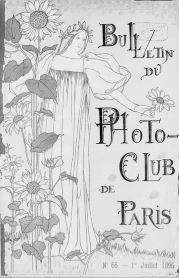
Similar groups were formed in other locations - in 1894 Robert Demachy and Émile Constant Puyo created the Photo-Club de Paris along with other photographers who had also seceded from Société de Francaise de Photographie a few years before. The Photo-Club organized an annual international photographic salon, the first of which opened in 1894 and continuing until 1897. In connection with the salon, the club published official bulletins and portfolio albums of gravure prints which art historian Janet Buerger has described, as being of "superior quality".
The Photo-Secession
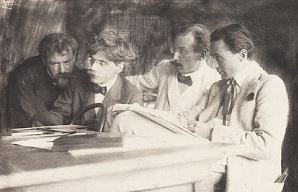
In 1902 with Edward Steichen, Alfred Stieglitz started the Photo-Secession, based upon the model of the Linked Ring Society, of which he had been a member. His use of the word 'secession' was also derived from the formation of the Linked Ring, which had first taken shape when Henry Peach Robinson and other photographers seceded from the Photographic Society of Britain to pursue and advocate for Pictorialism. In 1903 Stieglitz described the Photo-Secession in a statement, "Its aim is loosely to hold together those Americans devoted to pictorial photography in their endeavor to compel its recognition, not as the handmaiden of art, but as a distinctive medium of individual expression. The attitude of its members is one of rebellion against the insincere attitude of the unbeliever, of the Philistine, and largely of exhibition authorities".
Unlike other camera societies of the era, membership was not by official selection, but upon mutual compatibility, and the approval of Stieglitz. Stieglitz was to describe how he answered Gertrude Käsebier's question whether she was a Photo-Secessionist, by saying that "if she felt she was, that's all there is to it." Most of Stieglitz's fellow photographers joined the group, and Stieglitz's close friendship with artists from other countries such as Heinrich Kühn, gave the society an international scope. Stieglitz became the leader of the Pictorialist movement and the group largely took over from the Linked Ring.
Camera Work, 1903
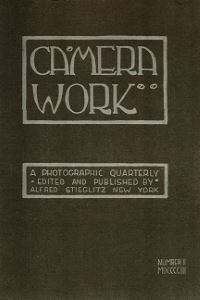
The first issue of Stieglitz's Pictorialist journal, Camera Work, appeared in January, 1903, and included, "Only examples of such work as gives evidence of individuality and artistic worth, regardless of school, or contains some exceptional feature of technical merit". The magazine, which appeared quarterly, contained reviews of national and international photographic exhibitions and high-quality photogravure images in each issue. Noted photographers of the Photo-Secession, such as James Craig Annan, Frank Eugene, Gertrude Käsebier, Edward Steichen, Alvin Langdon Coburn, and Clarence White, were featured in the magazine's early issues.
The Little Galleries of the Photo-Secession
In 1905 at the urging of Edward Steichen and with his support, Stieglitz founded The Little Galleries of the Photo-Secession at 291 Fifth Avenue, the same apartment building where Steichen lived, in New York City. The three small rooms that Stieglitz rented became an artistic hub as Stieglitz intended, saying that its "small, but very select, shows" would display works "worthy of Secessionist methods". The gallery became a hub for artists, as well as a place known for exhibiting the latest in artistic photography, until 1908 when it was forced to close due to economic pressures. With the help of Paul Haviland, a wealthy donor, Stieglitz opened a new gallery the same year, this became known as 291.
Tensions developed within the group over the next couple of years, notably between Stieglitz and his longtime colleagues Gertrude Käsebier and Clarence H. White. This was driven, in part, by a divergence in photographic styles, as both Käsebier and White remained Pictorialists throughout their careers whilst Stieglitz and Steichen, along with other photographers, moved in the direction of Modernism and New Vision.
Pictorialism: Concepts, Styles, and Trends
Pictorialism, Tonalism, and Impressionism
Pictorialist photographers followed the artistic models of their time, as seen in the early composites of Rejlander which draw upon Academic painting. The greatest impact, however, came from the Tonalist and Impressionist movements which emphasized the treatment of light.
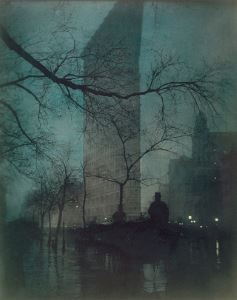
Stieglitz, in images such as his Spring Showers (1902), borrowed the Tonalist use of soft focus to create a sense of 'atmosphere', stating that "Atmosphere is the medium through which we see all things. In order, therefore, to see them in their true value on a photograph, as we do in Nature, atmosphere must be there. Atmosphere softens all lines; it graduates the transition from light to shade; it is essential to the reproduction of the sense of distance. That dimness of outline which is characteristic for distant objects is due to atmosphere." Steichen, too, became celebrated for his use of Tonalism as seen in works like The Flatiron (1904) which depicts the noted New York City building at twilight.
Impressionism was equally influential upon Pictorialists, notably George Davison who utilized a variety of camera and printing techniques to achieve an Impressionist effect. The German Heinrich Kuhn experimented with a number of color processes in order to create Impressionist portrayals of his family and friends.
Composite Images
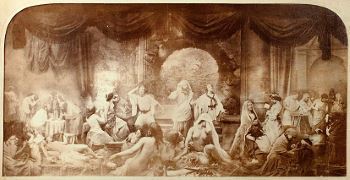
Images could be made up of composite parts of different photographs and this allowed photographers to create large narrative scenes, re-imagine portraits, and to create allegorical works. One of the early noted examples was Oscar Rejlander's allegorical Two Ways of Life (1857), which combined thirty two images in a single photo to show two young men being offered a choice by a fatherly figure between lives of virtue or sin.
Henry Peach Robinson used the technique to create moving works with a strong storytelling element such as Fading Away (1858) and The Lady of Shalott (1861), whilst the American F. Holland Day created images where a sacred context was combined with self-portraiture as seen in his The Last Seven Words of Christ. In the 20th century photographers such as William Mortensen continued to explore the composite in his macabre and Hollywood inspired images.
The Development of Gum Bichromate and Color Processes
In the mid-1890s, Frenchman Robert Demachy revived and refined the technique of gum bichromate and this allowed for the introduction of color and brush-like effects into photographs. The gum bichromate process involved applying pigment, gum Arabic, and potassium bichromate to the paper. When developed under light, the gum bichromate would remain pliable for a period of time, allowing the photographer to manipulate the surface of the photograph to create various painterly effects.
Photographers often favored particular colors, as seen in Robert Demachy's preferred orange tones and Steichen's use of blue-green. To make oil prints, photographers such as the Frenchman Émile Constant Puyo would apply gelatin, gum bichromate, and oily ink to paper. The surface would harden when struck by the light and then the photographer could apply other ink to the surface. Demachy's innovations in gum printing had a profound influence on Pictorialism and in 1904 Stieglitz called him "the father of gum-printing," and promoted his works as "of exceptional value", Demachy also published various articles on the process and became known for his international advocacy of it.
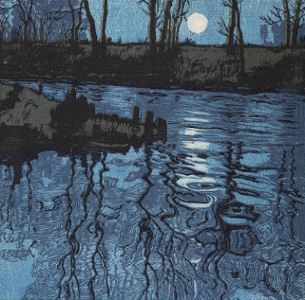
Austrian Pictorialists played a significant role with their later innovations in darkroom techniques and color processes. In the late 1890s a trio of photographers, Hugo Henneberg, Heinrich Kühn, and Hans Watzek, became known as Das Kleeblatt or The Trifolium. Henneberg was previously known for his landscapes such as Motiv aus Pommern (1895-1896), but, influenced by ukiyo-e artist Katsushika Hokusai and the Art Nouveau painter Carl Moll, he began to experiment with color. His explorations included employing the gum bichromate techniques popularized in France as well as applying new and various printing processes, as shown in his linocut print, Der Blaue Weiher (The Blue Pond) (1904).
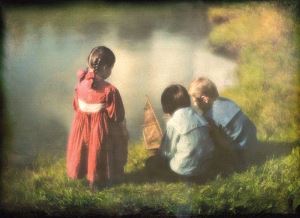
The most noted member of the group, Kühn was already known for his Pictorialist images that resembled Impressionist paintings. An ardent innovator, he created a soft focus camera lens, and Gummigravüre, a process that combined photogravure with gum bichromate. He was also an early pioneer of using Autochrome, a color process, and later he invented his Syngraphie, a technique where two negatives with different sensitivity were combined to create a greater tonal spectrum.
Later Developments - After Pictorialism
Pictorialism as an active movement declined around 1915 as some of its key advocates such as Stieglitz and Steichen turned to other visual modes, notably Straight Photography. This was a style that rejected the manipulative techniques of Pictorialism and instead sought to produce uncropped images with a sharp focus and high contrast between colors. The movement also had a modernist interest in geometric shapes and structures. Developments in Straight Photography in the US were paralleled by the New Vision photography movement in Europe, which was led by Moholy-Nagy and was linked to the Bauhaus.
Nonetheless Pictorialism continued to be a preferred technique of many local and regional camera clubs as late as the 1940s and some Pictorialists including Clarence H. White and Gertrude Käsebier continued to work in the mode throughout their careers. In the 1960's there was an explosion of interest in alternative modes of photographic printmaking, leading to a revival of interest in pinhole cameras, platinum and gum bichromate prints, and oil and bromoil pigment processes. Artists like Sheila Metzner, Betty Hahn, Robert Fichter, David Scopick, and Stephen Livick, explored pigment processes and Dick Arentz, and George Tice developed platinum prints.
In 1965 Jerry Uelsmann argued that by using 'Post-Visualization' photographers could revisualize their images via darkroom manipulations. His works such as Allegorical Landscape (1963) are composite images created in the darkroom and have been called Neo-Pictorialist. Some art historians have described the composite photographs and staged self-portraits of contemporary photography as Post-Pictorialism. The composite images of Robinson are seen as an important precursor of the work of Jeff Wall, the tableaux of Gregory Crewdson, and the theatricality of Philip-Lorca DeGorcia.
Useful Resources on Pictorialism
-
![Pictorialism]() 85k viewsPictorialismOur PickThe Art of Photography
85k viewsPictorialismOur PickThe Art of Photography -
![Color Photographs from 1907: Autochrome and Pictorialism]() 112k viewsColor Photographs from 1907: Autochrome and PictorialismThe Art of Photography
112k viewsColor Photographs from 1907: Autochrome and PictorialismThe Art of Photography
-
![Pictures from a Glass House: Julia Margaret Cameron's Portraits]() 24k viewsPictures from a Glass House: Julia Margaret Cameron's PortraitsOur PickSan Francisco Museum of Art
24k viewsPictures from a Glass House: Julia Margaret Cameron's PortraitsOur PickSan Francisco Museum of Art -
![Masters of Photography: Henry Peach Robinson]() 16k viewsMasters of Photography: Henry Peach RobinsonOur Pick
16k viewsMasters of Photography: Henry Peach RobinsonOur Pick -
![Masters of Photography: Gertrude Käsebier]() 60k viewsMasters of Photography: Gertrude Käsebier
60k viewsMasters of Photography: Gertrude Käsebier
-
![An Introduction to Julia Margaret Cameron talk by Marta Weiss]() 5k viewsAn Introduction to Julia Margaret Cameron talk by Marta WeissVictoria and Albert Museum
5k viewsAn Introduction to Julia Margaret Cameron talk by Marta WeissVictoria and Albert Museum -
![Photography: a Victorian Sensation -Amateur Photographers: Julia Margaret Cameron]() 5k viewsPhotography: a Victorian Sensation -Amateur Photographers: Julia Margaret CameronOur PickAnne Lyden, curator National Galleries of Scotland, talk
5k viewsPhotography: a Victorian Sensation -Amateur Photographers: Julia Margaret CameronOur PickAnne Lyden, curator National Galleries of Scotland, talk -
![Lecture Clarence H. White and His World: The Craft of Photography 1895-1925]() 869 viewsLecture Clarence H. White and His World: The Craft of Photography 1895-1925Our PickTalk with Anne McCauley and David Hunter McAlpin / Princeton University Art Museum
869 viewsLecture Clarence H. White and His World: The Craft of Photography 1895-1925Our PickTalk with Anne McCauley and David Hunter McAlpin / Princeton University Art Museum -
![Meet Gertrude Käsebier]() 117 viewsMeet Gertrude KäsebierOur PickTalk by Michelle Delaney / William F. Cody Archive
117 viewsMeet Gertrude KäsebierOur PickTalk by Michelle Delaney / William F. Cody Archive
 Ask The Art Story AI
Ask The Art Story AI